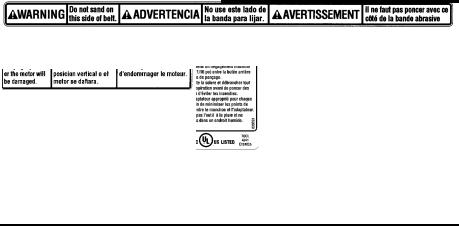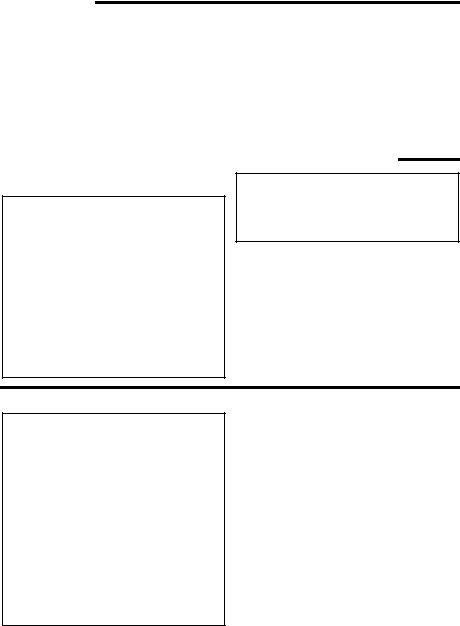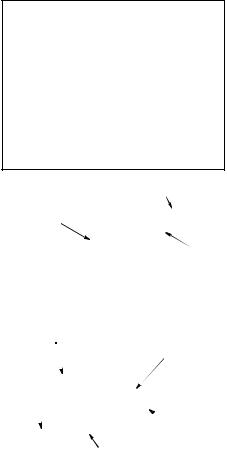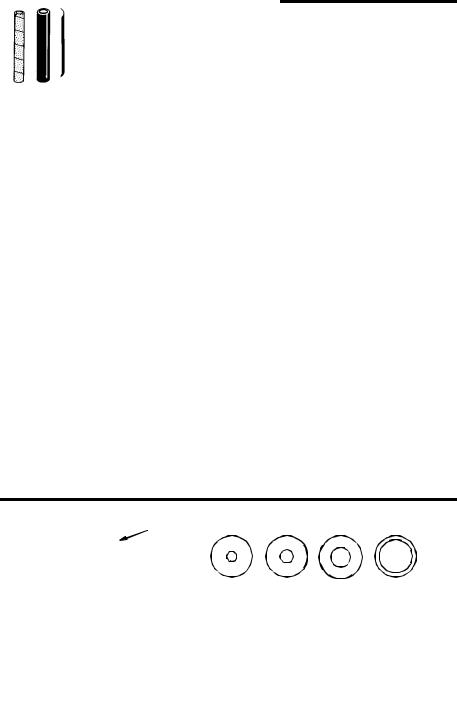Ridgid EB4424 User Manual


Table of Contents |
|
|
Section |
Page |
|
Table of Contents ................................. |
|
2 |
Safety Instructions For Oscillating |
|
|
Edge Belt/ Spindle Sander .................. |
|
3 |
Safety Signal Words ............................ |
|
3 |
Before Using The Sander .................... |
|
3 |
When Installing Or Moving The |
|
|
Sander ............................................... |
|
4 |
Before Each Use ................................. |
|
5 |
Plan Ahead To Protect Your Eyes, |
|
|
Hands, Face and Ears ....................... |
|
5 |
When Sander is Running .................... |
|
7 |
Before Leaving The Sander ................ |
|
7 |
Precautions To Take When Sanding |
|
|
Metals ............................................... |
|
7 |
Precautions To Take When Sanding |
|
|
Paint .................................................. |
|
7 |
Motor Specifications and Electrical |
|
|
Requirements .................................. |
|
8 |
General Electrical Connections ........... |
|
8 |
Power Supply and Motor |
|
|
Specifications .................................... |
|
8 |
110-120 Volt, 60 Hz. Tool Information . 9 |
||
Motor Safety Protection ..................... |
|
10 |
Wire Sizes ......................................... |
|
10 |
Unpacking and Checking Contents . 11 |
||
List of Loose Parts ............................. |
|
11 |
Loose Parts ....................................... |
|
11 |
Assembly ............................................ |
|
12 |
Mounting Rubber Feet To Base ........ |
|
12 |
Parts Storage .................................... |
|
12 |
Removing the Sanding Belt Assembly 13 |
||
Installing the Sanding Belt Assembly |
13 |
|
Installing Sanding Sleeves Larger |
|
|
than 1/2" Diameter ........................... |
|
14 |
Installing Sanding Sleeves for the 1/2" |
||
Diameter Sanding Drum .................. |
|
15 |
Selection Of Spacer Ring Inserts And |
|
|
Upper Spindle Washers .................. |
|
15 |
Bolting Oscillating Edge Belt/Spindle |
|
|
Sander To Workbench .................... |
|
16 |
Section |
Page |
Supporting Oscillating Edge Belt/ |
|
Spindle Sander to Sawhorses ......... |
17 |
Alignment ........................................... |
17 |
Squaring Front Table ........................ |
17 |
Aligning Belt To Miter Gauge Slot ..... |
18 |
Removing/Installing the Sanding Belt 19 |
|
Tensioning and Tracking ................... |
19 |
Getting to Know Your Spindle |
|
Sander ............................................ |
20 |
On-Off Switch .................................... |
21 |
Safety Instructions for Oscillating Edge |
|
Belt/Spindle Sander ...................... |
22 |
Before Using The Sander .................. |
22 |
When Installing Or Moving The |
|
Sander ............................................. |
22 |
Before Each Use ............................... |
22 |
Plan Ahead To Protect Your Eyes, |
|
Hands, Face and Ears .................... |
23 |
When Sander is Running .................. |
24 |
Before Leaving The Sander .............. |
25 |
Precautions To Take When Sanding |
|
Metals ............................................. |
25 |
Precautions To Take When Sanding |
|
Paint ............................................... |
25 |
Basic Sanding Operation .................. |
26 |
Sandpaper Selection ......................... |
26 |
Surface Sanding on the Sanding Belt 27 |
|
End Sanding on the Sanding Belt ..... |
27 |
Sanding Curved Edges ..................... |
27 |
Feed Direction ................................... |
28 |
Dust Collection Capability ................. |
28 |
Transporting Sander ......................... |
28 |
Maintenance ....................................... |
29 |
Lubrication ......................................... |
29 |
RIDGID Recommends the Following |
|
Accessories ................................... |
29 |
Wiring Diagram .................................. |
29 |
Troubleshooting ................................ |
30 |
Repair Parts ....................................... |
32 |
Notes .................................................. |
35 |
2

Safety Instructions For Oscillating Edge Belt/
Spindle Sander
Safety is a combination of common |
WARNING: means if the safety infor- |
sense, staying alert and knowing how |
mation is not followed someone |
your oscillating edge belt/spindle |
could be seriously injured or killed. |
sander works. Read this manual to |
CAUTION: means if the safety infor- |
understand this sander. |
mation is not followed someone may |
Safety Signal Words |
be injured. |
DANGER: means if the safety infor- |
|
mation is not followed someone will |
|
be seriously injured or killed. |
|
|
|
Before Using The Sander |
|
WARNING: Some dust created by power sanding, sawing, grinding, drilling, and other construction activities contains chemicals known (to the State of California) to cause cancer, birth defects or other reproductive harm. Some examples of these chemicals are:
•Lead from lead-based paints,
•Crystalline silica from bricks and cement and other masonry products, and
•Arsenic and chromium from chemically-treated lumber.
Your risk from these exposures varies, depending on how often you do this type of work. To reduce your exposure to these chemicals: work in a well ventilated area, and work with approved safety equipment, such as those dust masks that are specially designed to filter out microscopic particles.
WARNING: To reduce the risk of mistakes that could cause serious, permanent injury, do not plug the sander in until the following steps are completed.
•Assembly. (See pages 12-19)
•Learn the use and function of the ON-OFF switch. (See page 21)
•Review and understanding of all safety instructions and operating procedures in this manual.
•Review of the maintenance methods for this sander. (See page 29)
3

Safety Instructions for Oscillating Edge Belt/ Spindle Sander (continued)
Read the following WARNING labels found on the sander:
When Installing Or Moving The Sander
Avoid dangerous environment.
Use the sander in a dry, indoor place protected from rain. Keep work area well lighted.
To reduce the risk of burns or other fire damage, never use the sander near flammable liquids, vapors or gasses.
To reduce the risk of injury or death from electrical shock:
•Ground the sander. This sander has an approved 3-conductor cord and a 3-prong grounding type plug. Use only 3-wire, grounded outlets rated 120 volts, 15 amperes (amps). The green conductor in the cord is the grounding wire. To reduce the risk of electrocution, Never connect the green wire to a live terminal.
•Make sure your fingers do not touch the plug’s metal prongs when plugging or unplugging the sander.
•Never use this or any power sander for wet sanding. Doing so could
cause electrocution, serious injury or worse.
To reduce the risk of injury from unexpected sander movement:
•Always unplug the sander before moving it.
•Put the sander on a firm level surface where there is plenty of room for handling and properly supporting the workpiece.
•Attach rubber feet.
•Support the sander so it does not rock.
•Bolt the sander to its work surface. Use the fasteners and method shown in “Assembly.” (See page 16.)
•Never stand on tool. Serious injury could occur if the tool tips. Do not store anything above or near the tool where anyone might stand on the tool to reach it.
4

Before Each Use
Inspect your sander. Check for:
•alignment of moving parts,
•binding of moving parts,
•broken or damaged parts,
•work parts that cause a gap larger than 1/16" between work support and sanding surface,
•sanding belt narrower than 4 inches. Narrower belts uncover parts that could trap your fingers,
•worn or damaged electric cords,
•stable mounting, and
•any other conditions that may affect the way the sander works.
•Remove adjusting keys and wrenches. Form a habit of checking for and removing keys and adjusting wrenches from table top before turning sander on.
If any part is missing, bent, or broken in any way, or any electrical parts don’t work properly, turn the sander off and unplug the sander. Replace damaged, missing, or failed parts before using the sander again.
Disconnect the sander to reduce the risk of injury from accidental starting. Turn switch off, unplug sander and remove the switch key before changing the setup or sanding drum.
Maintain tools with care. Keep the sander clean for maximum and safest performance.
To reduce the risk of injury from jams, slips or thrown pieces:
•Use only recommended accessories.
•Use the correct spacer ring insert.
The opening between the sanding sleeve and insert must be 5/32 of an inch or less. (See page 15)
•All sanding drums, washers and knobs are tight. No parts should have excessive play prior to operating unit.
•Keep work area clean. Cluttered work surfaces invite accidents. Floor must be clean and dry for stable footing.
Plan Ahead To Protect Your Eyes, Hands, Face and Ears
Dress for Safety
•Any power sander can throw foreign objects into the eyes. This can result in permanent eye damage. Always wear safety goggles, not glasses complying with ANSI Z87.1 (or in Canada CSA Z94.3-99) shown on package. Everyday eyeglasses have only impact resistant lenses. They are not safety glasses. Safety goggles are available at many local retail stores. Glasses or goggles not in compliance with ANSI or CSA could seriously hurt you when they break.
•Sanding operations are usually dusty. Wear a dust mask along with the safety goggles.
•Wear nonslip footwear.
•Tie back long hair.
•Roll long sleeves above the elbow.
•Noise levels vary widely. To reduce the risk of possible hearing damage, wear ear plugs or muffs when using sander for hours at a time.
5

Safety Instructions for Oscillating Edge Belt/
Spindle Sander (continued)
•Do not wear loose clothing, gloves, neckties or jewelry (rings, wrist watches). They can get caught and draw you into moving parts.
Know your sander. Read and understand the owner’s manual and labels affixed to the tool. Learn its application and limitations as well as the specific potential hazards.
Plan your work. Think through how you will hold and maneuver the workpiece against the sanding drum or belt.
Use the right tool. Don’t force tool or attachment to do a job it was not designed to do.
To reduce the risk of injury from accidental contact with moving parts:
•Do not layout, assemble, or setup work on the sander while any parts are moving.
•Reduce the risk of accidental starting. Make sure switch is “OFF” before plugging sander into a power outlet.
Inspect your workpiece. Make sure there are no nails or foreign objects in the part of the workpiece to be sanded.
Plan the way you will hold the workpiece from start to finish. Reduce the risk of awkward operations and hand positions where a sudden slip could cause finger or hand to move into a sanding surface.
Don’t overreach. Maintain balance and footing.
Keep face and body to one side. Stay out of line of a possible throwback.
Plan your work to reduce the risk
of THROWBACKS - when the workpiece catches the sanding drum and is torn from your hands:
•Make sure there is no debris between the workpiece and its supports.
•When sanding irregularly shaped workpieces, plan your work support so it will not slip and be pulled from your hands.
•Use extra caution with large, very small or awkward workpieces.
•Never use this tool to finish pieces too small to hold by hand.
•Use extra supports (tables, saw horses, blocks, etc.) for any workpieces large enough to tip when not secured to the work surface.
•Never use another person as a substitute for a table extension, or as additional support for a workpiece that is longer or wider that the basic sander table, or to help feed, support or pull the workpiece.
•Sand only one workpiece at a time.
•Clear everything except the workpiece and related support devices off the table before turning the sander on.
•Always feed workpiece from right to left against the direction the sanding sleeve or belt is rotating.
•Do not use drums, sanding sleeves or sanding belts which show visual signs of wear such as grooves, tears or rips.
WARNING: Don’t let familiarity (gained from frequent use of your sander) cause a careless mistake. A careless fraction of a second is enough to cause a severe injury.
6

When Sander is Running
Before starting your work, watch the sander while it runs. If it makes an unfamiliar noise or vibrates excessively, Stop Immediately. Turn the sander off. Unplug the sander. Do not restart until identifying and correcting the problem.
Never leave tool running unattended.
tors a safe distance from the sander and workpiece.
Don’t force tool. It will perform better and safer at its designed rate. Press workpiece against the sanding sleeve hard enough to begin sanding without bogging down or binding spindle or belt.
Before freeing any jammed material:
Before using the sander, make sure |
• Turn switch “OFF”. |
the sanding belt turns clockwise, |
• Unplug the sander. |
when viewed from above. |
• Wait for all moving parts to stop. |
Keep children away. Keep all visi- |
|
Before Leaving The Sander
Turn switch off. Don’t leave tool until the unit comes to a complete stop.
Make workshop child-proof.
Remove the yellow switch key. Store
it away from children and others not qualified to use the tool. Disconnect master switches. Lock the shop.
Precautions To Take When Sanding Metals
When sanding metals, sparks or hot fragments could cause a fire. To reduce the risk of this:
1.Disconnect any dust collecting hose from the sander.
2.Remove all traces of wood dust from inside the unit before sanding metals.
3.Remove all traces of metal dust from inside the unit before sanding wood again.
Precautions To Take When Sanding Paint
Sanding of lead based paint is not recommended. It is difficult to control the contaminated dust that could cause lead poisoning.
It is also difficult to identify whether or not a paint contains lead. Therefore, we recommend the following precautions when sanding all paints:
1.Protect your lungs. Wear a dust mask or respirator at all times. Wear only dust masks that are suitable for working in lead paint sanding environments. Ordinary painting masks do not offer this protection.
2.Do not allow children or pregnant women to enter the work area until paint sanding job is complete and work area is clean.
3.To prevent ingesting contaminated paint particles: Do not eat, drink, or smoke in a work area where paint is being sanded. After sanding paint, wash and clean up before eating, drinking or smoking. Do not leave food, drinks, or tobacco products in the work area where dust can settle on them.
7

Precautions To Take When Sanding Paint
(continued)
4.Protect the environment when sanding paint. Use a dust collection system if possible. Seal the work area with plastic if necessary. Do not track paint dust outside the work area.
5.Thoroughly clean the work area upon completion of paint sanding
project. If project lasts for an extended period of time, clean work area often. Items such as sanding dust, vacuum filter bags, plastic drop cloths, etc. should be placed in a sealed container and disposed of properly. Clean all items exposed to sanding dust.
Motor Specifications and Electrical Requirements
General Electrical Connections
DANGER: To reduce the risk of electrocution:
1.Use only identical replacement parts when servicing. Servicing should be performed by a qualified service technician.
2.Do not use in rain or where floor is wet.
This tool is intended for indoor use only.
WARNING: Do not touch the terminals of plug when installing or removing the plug to or from the outlet.
If power cord is worn or cut, or damaged in any way, have it replaced immediately.
Power Supply and Motor Specifications
WARNING: To reduce the risk of electrical hazards, fire hazards or damage to the tool, use proper circuit protection. Your tool is wired at the factory for operation using the voltage shown. Connect tool to a power line with the appropriate voltage and a 15-amp branch circuit. To reduce the risk of shock or fire, if power cord is worn or cut, or damaged in any way, have it replaced immediately.
The A-C motor used on this tool is a relay start motor, having the following specifications: It is wired at the factory for operation on 110-120V AC, 60 Hz. operation.
Rated H.P. |
3/8 |
|
|
Voltage |
110-120 |
|
|
Amperes |
5.0 |
|
|
Hertz (Cycles) |
60 |
|
|
Phase |
Single |
|
|
RPM |
1725 |
|
|
Rotation of Shaft |
Clockwise |
|
|
8

110-120 Volt, 60 Hz. Tool
Information
NOTE: The plug supplied on your tool may not fit into the outlet you are planning to use. Your local electrical code may require slightly different power cord plug connections. If these differences exist refer to and make the proper adjustments per your local code before your tool is plugged in and turned on.
In the event of a malfunction or breakdown, grounding provides a path of least resistance for electric current to reduce the risk of electric shock. This tool is equipped with an electric cord having an equipment grounding conductor and a grounding plug, as shown. The plug must be plugged into a matching outlet that is properly installed and grounded in accordance with all local codes and ordinances.
Do not modify the plug provided. If it will not fit the outlet, have the proper outlet installed by a qualified electrician.
A temporary adapter may be used to connect this plug to a 2-pole outlet, as shown, if a properly grounded outlet is not available. This temporary adapter should be used only until a properly grounded outlet can be installed by a qualified electrician. The green colored rigid ear, lug and the like, extension from the adapter must be connected to a permanent ground such as a properly grounded outlet box.
Improper connection of the equipment grounding conductor could result in a risk of electric shock. The conductor with insulation having an outer surface that is green with or without yellow stripes is the equipment grounding conductor. If repair or replacement of the electric cord or plug is necessary, do not connect the equip- ment-grounding conductor to a live terminal.
If the grounding instructions are not completely understood, or if you are in doubt as to whether the tool is properly grounded, check with a qualified electrician or service personnel.
WARNING: If not properly grounded, this tool can cause an electrical shock, particularly when used in damp locations, in proximity to plumbing, or out of doors. If an electrical shock occurs there is the potential of a secondary hazard, such as your hands contacting the sanding belt/spindle.
Properly |
3-Prong Plug |
Grounded |
|
3-Prong Outlet |
|
|
Grounding |
|
Prong |
Make sure this Is Connected
Grounding Lug to a Known Ground
3-Prong Plug
2-Prong  Outlet
Outlet
Adapter
NOTE: The adapter illustrated is for use only if you have a properly grounded 2- prong outlet.
NOTE: In Canada the use of a temporary adapter is not permitted by the Canadian Electrical Code.
9

Motor Specifications and Electrical Requirements (continued)
Motor Safety Protection
IMPORTANT: To reduce the risk of motor damage, the motor should be blown out or vacuumed frequently to keep sawdust from interfering with normal motor ventilation.
1.Connect this tool to a power source with the appropriate voltage for your model and a 15-amp branch circuit with
a15-amp fuse or circuit breaker. Using the wrong size fuse can damage the motor.
2.If the motor won't start, turn off the power switch immediately and unplug the tool. Check the spindle to make sure it turns freely. If the spindle is free, try to start the motor again. If the motor still does not start, refer to the "Troubleshooting” chart.
3.If the motor suddenly stalls while sanding, turn off the power switch, unplug the tool, and remove the workpiece from the belt/drum. The motor may now be restarted and the sanding finished.
4.Fuses may "blow" or circuit breakers may trip frequently if:
a.Motor Is Overloaded-Overloading can occur if you sand too rapidly or make too many start/stops in a short time.
b.Line voltages should not be more
than 10% above or below the nameplate voltage. For heavy loads, however, the voltage at motor terminals must equal the voltage specified for your model.
5.Most motor troubles may be traced to loose or incorrect connections, overload, low voltage (such as small size wire in the supply circuit) or to overly long supply circuit wire. Always check the connections, the load and supply circuit whenever motor doesn't work well. Check wire sizes and extension cord length with the Wire Size Chart.
Wire Sizes
NOTE: Make sure the proper extension cord is used and is in good condition. The use of any extension cord will cause loss of power. To keep this to a minimum and to prevent overheating and motor burn-out, use the table shown to determine the minimum wire size (A.W.G.) extension cord.
Use only 3-wire extension cords with 3- prong grounding type plugs and 3-pole receptacles.
Extension Cord |
Gauge (A.W.G.) |
|
Length |
||
|
||
|
|
|
0-25 Ft. |
16 |
|
26-50 Ft. |
14 |
|
|
|
10

Unpacking and Checking Contents
1. Remove tool from carton by lifting unit. |
Item |
Description |
Qty. |
|
2. Place the tool on a secure, stationary |
A |
Oscillating Edge Belt/ |
|
|
work surface and look the tool over |
|
Spindle Sander................................ |
1 |
|
carefully. |
B |
Spacer Ring Inserts |
|
|
|
|
1/2" I.D |
|
1 |
WARNING: For your own safety, |
|
|
||
|
1" I.D |
|
1 |
|
never connect plug to power |
|
|
||
|
1-1/2" I.D |
|
1 |
|
source outlet, or insert switch |
|
........................................ |
||
|
2" I.D. .............................................. |
|
1 |
|
key until all assembly steps are |
C Drums |
|
|
|
complete and until you have read |
|
3/4" x 4-1/2"..................................... |
1 |
|
and understood the entire own- |
|
1" x 4-1/2"........................................ |
1 |
|
ers manual. |
|
1-1/2" x 4-1/2" ................................. |
1 |
|
|
|
2" x 4-1/2" |
1 |
|
|
|
|||
WARNING: To reduce the risk of |
|
|||
D |
Sandpaper Sleeves |
|
||
injury, if any parts are missing, |
|
|||
|
1/2" x 4-1/2"..................................... |
1 |
||
do not attempt to assemble the |
|
3/4" x 4-1/2"..................................... |
1 |
|
sander, plug in the power cord, |
|
1" x 4-1/2"........................................ |
1 |
|
or turn the switch on until the |
|
1-1/2" x 4-1/2" ................................. |
1 |
|
missing parts are obtained and |
|
2" x 4-1/2"........................................ |
1 |
|
installed correctly. |
E |
Sanding Belt (Installed) |
|
|
|
|
4" x 24"............................................ |
|
1 |
List of Loose Parts |
|
|
||
F |
Insert |
|
1 |
|
NOTE: Before beginning assembly, check |
|
|||
G |
Operators Manual ........................... |
1 |
||
that all parts are included. If you are miss- |
H |
Bag of Loose Parts |
|
|
ing any part, do not assemble the sander. |
Containing the following parts: |
|
|
Call 1-866-539-1710 or E-mail us at |
Rubber feet |
4 |
|
info@ridgidwoodworking.com if any parts |
|||
Washer, Flat 21/64 x 1-3/4 x 1/8 |
1 |
||
are damaged or missing. Sometimes |
|||
Washer, Flat 21/64 x 7/8 x 3/64 |
1 |
||
small parts can get lost in packaging |
|||
Washer, Flat 21/64 x 5/8 x 1/32 |
1 |
||
material. Do not throw away any packag- |
|||
Switch Key |
1 |
||
ing until sander is put together. Check |
|||
Hex “L” Wrench 3/32 |
1 |
||
packaging for missing parts before con- |
|||
Hex “L” Wrench 5/32 |
1 |
||
|
tacting RIDGID.
Loose Parts
A |
|
E |
|
Spacer Ring Inserts |
|
||
|
|
B |
|
|
|
|
|
|
|
|
|
|
|
|
|
|
|
|
|
1/2" |
1" |
1-1/2" |
2" |
|
|
|
|
Drums and Sandpaper Sleeves |
|||
F |
G |
H |
C |
D |
|
|
|
|
|
|
|
|
|||
|
|
|
|
|
|
|
|
|
|
|
1/2" |
3/4" |
1" |
1-1/2" |
2" |
NOTE: The sander is shipped with the 4" x 24" sanding belt attached. NOTE: Parts shown are not actual size.
11
